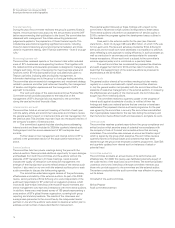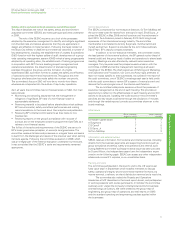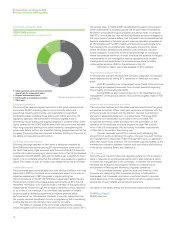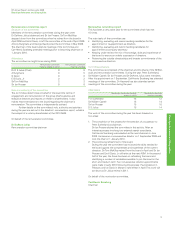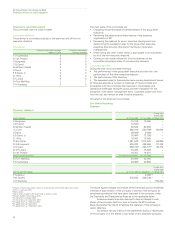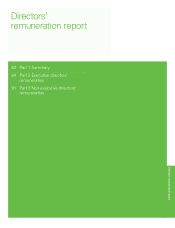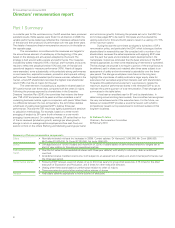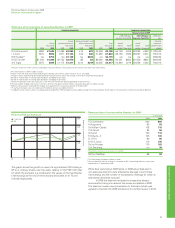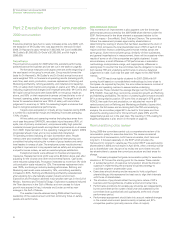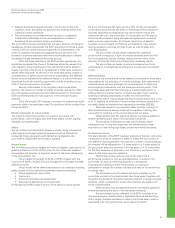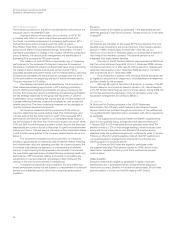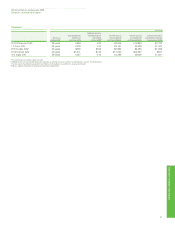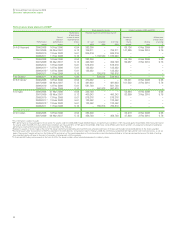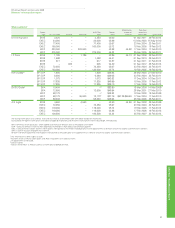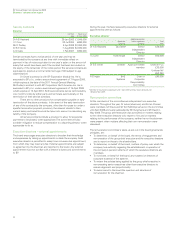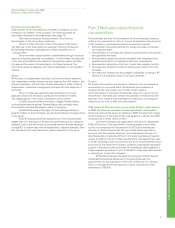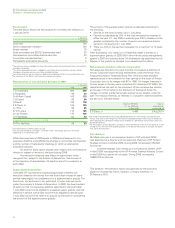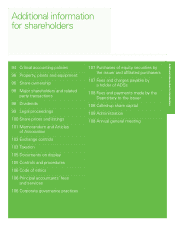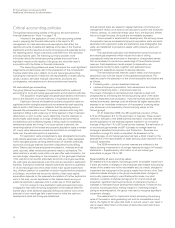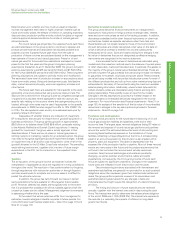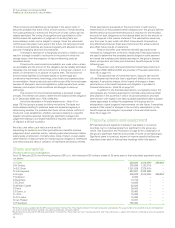BP 2009 Annual Report Download - page 88
Download and view the complete annual report
Please find page 88 of the 2009 BP annual report below. You can navigate through the pages in the report by either clicking on the pages listed below, or by using the keyword search tool below to find specific information within the annual report.
86
BP Annual Report and Accounts 2009
Directors’ remuneration report
Performance conditions
Performance conditions for the 2010-12 share element will continue the
structure used in the 2009-2011 plan.
Vesting of shares will be based, as to one-third, on BP’s TSR
compared with other oil majors over a three-year period and as to
two-thirds, on a balanced scorecard of underlying performance. BP’s
TSR performance will be compared with the other oil majors –
ExxonMobil, Shell, Total, ConocoPhillips and Chevron. This comparison
group can be altered if circumstances change, for example, if there is
significant consolidation or change in the industry. While this comparison
group is narrow, it is used by both management and shareholders in
assessing BP’s comparative TSR performance.
The inclusion of relative TSR is an appropriate way of measuring
performance for the purposes of a long-term incentive for executive
directors as it reflects the creation of shareholder value while minimizing
the impact of sector specific events such as the oil price. TSR is
calculated as share price performance over the relevant period, assuming
dividends are reinvested. All share prices are averaged over the three-
month period before the beginning and end of the performance period.
They are measured in US dollars.
The balanced scorecard will be assessed by the committee on
three measures reflecting key priorities in BP’s strategy, production
growth, Refining and Marketing profitability and group underlying net
income. Both production growth and Refining and Marketing profitability
are key strategic objectives for the group and key drivers of value for
shareholders. Group underlying net income acts as a holistic measure of
success reflecting revenues, costs and complexity as well as safe and
reliable operations. The three underlying measures will be averaged to
form the balanced scorecard component.
All the above measures will be compared with the other oil
majors to determine the overall vesting result. The methodology used
will rank each of the five other majors on each of the measures. BP’s
performance will then be compared on an interpolated basis relative to
the performance of the other five. Performance shares will vest at 100%,
70% and 35% for performance equivalent to first, second and third rank
respectively and none for fourth or fifth place. For performance between
second and third or first and second, the result will be interpolated based
on BP’s performance relative to the company ranked directly above and
below it.
The committee considers that this combination of measures
provides a good balance of external as well as internal metrics reflecting
both shareholder value and operating priorities. As in previous years, the
committee may exercise its discretion, in a reasonable and informed
manner, to adjust vesting levels upwards or downwards if it concludes
the quantitative approach does not reflect the true underlying health and
performance of BP’s business relative to its peers. It will explain any
adjustments in the next directors’ remuneration report following the
vesting, in line with its commitment to transparency.
In exceptional recruitment circumstances, the committee may
award performance shares that are subject to a requirement of continued
service over a specified period, rather than a corporate performance
condition.
Pensions
Executive directors are eligible to participate in the appropriate pension
schemes applying in their home countries. Details are set out in the table
on page 87.
UK directors
UK directors are members of the regular BP Pension Scheme. The core
benefits under this scheme are non-contributory. They include a pension
accrual of 1/60th of basic salary for each year of service, up to a
maximum of two-thirds of final basic salary and a dependant’s benefit of
two-thirds of the member’s pension. The scheme pension is not
integrated with state pension benefits.
The rules of the BP Pension Scheme were amended in 2006 such
that the normal retirement age is 65. Prior to 1 December 2006, scheme
members could retire on or after age 60 without reduction. Special early
retirement terms apply to pre-1 December 2006 service for members
with long service as at 1 December 2006.
Pension benefits in excess of the individual lifetime allowance set
by legislation are paid via an unapproved, unfunded pension arrangement
provided directly by the company.
Although Mr Inglis is, like other UK directors, a member of the BP
Pension Scheme, he is currently based in Houston, US. His participation
in the BP Pension Scheme gives rise to a US tax liability. During 2009, the
committee approved the discharge of this US tax liability under a tax
equalization arrangement amounting to $90,314.
US directors
Dr Grote and Mr Dudley participate in the US BP Retirement
Accumulation Plan (US plan) which features a cash balance formula.
Pension benefits are provided through a combination of tax-qualified and
non-qualified benefit restoration plans, consistent with US tax regulations
as applicable.
The Supplemental Executive Retirement Benefit (supplemental
plan) is a non-qualified top-up arrangement that became effective on
1 January 2002 for US employees above a specified salary level. The
benefit formula is 1.3% of final average earnings, which comprise base
salary and bonus in accordance with standard US practice (and as
specified under the qualified arrangement), multiplied by years of service.
There is an offset for benefits payable under all other BP qualified and
non-qualified pension arrangements. This benefit is unfunded and
therefore paid from corporate assets.
Dr Grote and Mr Dudley are eligible to participate under
the supplemental plan. Their pension accrual for 2009, shown in the
table below, includes the total amount that could become payable
under all plans.
Other benefits
Executive directors are eligible to participate in regular employee
benefit plans and in all-employee share saving schemes applying in
their home countries. Benefits in kind are not pensionable. BP provides
accommodation in London for both Mr Inglis and Mr Dudley.


